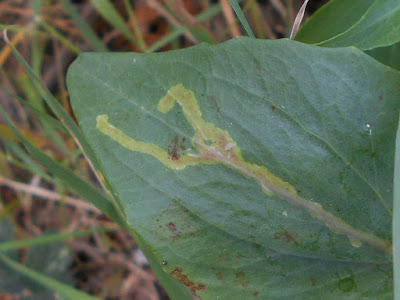First up was a clump of Red Valerian with the distinctive mine of Liriomyza strigata. Although it is polyphagous, attacking a range of plants, the mine caused by the larva always tends to follow the midrib of a leaf.
 |
| Leaves of Red Valerian had been mined by Liriomyza strigata. Stefen Hill Pocket Park, 2 August, 2019 |
The insect in question is a member of the Agromyzidae, a family of insects responsible for many a mine throughout the civilised world (plus the states of Georgia and Mississippi).
This long, sinuous gallery mine was on oak and is the work of a moth, Stigmella basiguttella. Common on oaks everywhere it has been called the Base-spotted Pigmy but of course no one uses the name.
 |
Looking like a meandering river, this mine is the work of a moth,
Stigmella basiguttella. Stefen Hill Pocket Park, 2 August, 2019
|
Mines are now to be seen on leaves everywhere but galls are appearing too. A distinctive one is Alder Tongue, Taphrina alni. I have mentioned this species before but I couldn't resist photographing a nice specimen today.
 |
Protruding from an alder catkin is the visible part of the fungus,
Taphrina alni. Stefen Hill Pocket Park, 2 August, 2019
|
Unusually it is a fungus and causes a distortion of the female catkins. Currently it is quite brightly coloured but withered brown-black specimens often remain on the catkins for months.
I examined the some oaks in the expectation that I would find knopper galls, Andricus quercuscalicis, present. Instead some of the acorn cups had been galled by Andricus grossulariae, a new wasp for the pocket park.
 |
A shaft of sunlight through the trees highlights the gall on an acorn cup.
Andricus grossulariae is the culprit. Stefen Hill Pocket Park,
August, 2019
|
Interesting (well, interesting to me) mines were found on Coltsfoot and Cinquefoil but I will not try the patience of my readers (over 70 logged on yesterday to peruse my ramblings). Instead I'll put the kettle on - far more important than blogging!
No comments:
Post a Comment